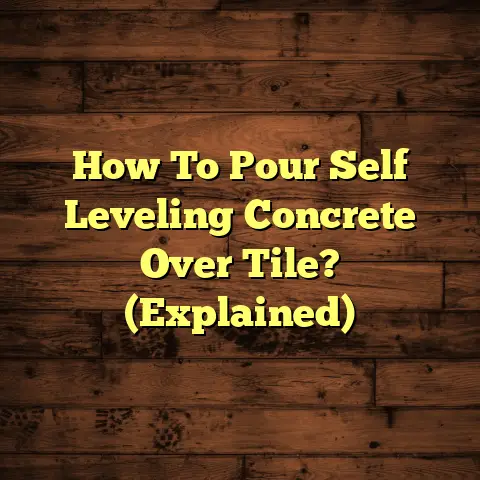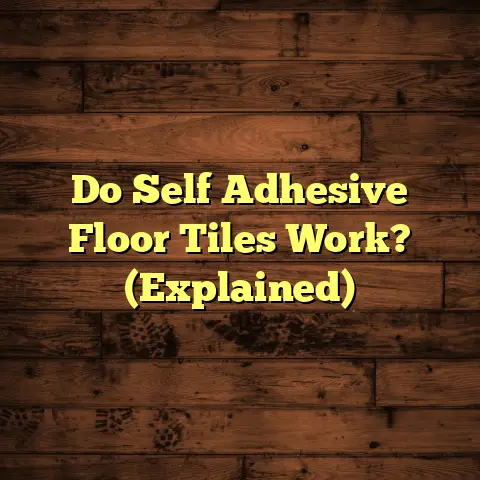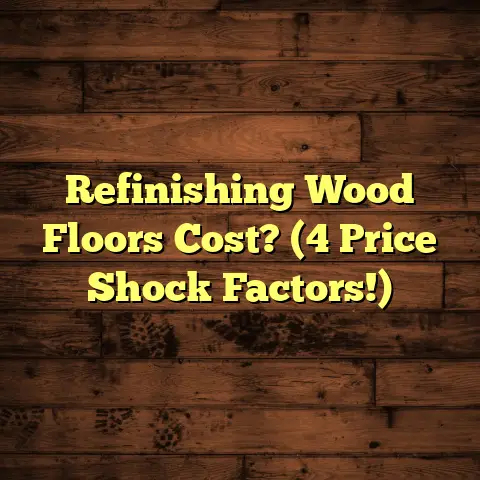AZ Home Floors: Best Choice? (3 Top Options!)
As I look out my window here in Phoenix, I see the sun blazing – it’s definitely summer!
And that got me thinking about something we all deal with: our floors.
Arizona’s climate is unique, right?
We’ve got scorching summers where the temperature can hit triple digits, and then surprisingly cool winter nights.
This wild swing in temperature really impacts what kind of flooring works best.
I’m talking comfort underfoot, durability, and even how energy-efficient your home is.
Flooring isn’t just something you walk on. It’s a huge part of your home’s design, comfort, and functionality.
Especially here in Arizona, where indoor-outdoor living is a big part of our lifestyle.
Choosing the right flooring can make or break your home’s overall feel.
So, what are the best options for Arizona homes? Let’s dive in!
Section 1: The Importance of Choosing the
Right Flooring in Arizona
Think about it: your flooring is one of the first things people notice when they walk in.
It sets the tone for your entire home.
Beyond aesthetics, it’s about durability and how well it stands up to daily life.
And in Arizona, “daily life” means battling extreme temperatures, intense sunlight, and the ever-present dust.
Arizona’s climate can be brutal on flooring.
The temperature fluctuations can cause some materials to expand and contract, leading to cracks or warping.
Humidity levels (or lack thereof) can also play a role, drying out some materials.
And let’s not forget the sun!
That intense Arizona sunshine can fade or damage certain types of flooring over time.
Choosing the right flooring can actually enhance your home’s energy efficiency.
For example, some materials, like tile, naturally stay cooler in the summer, reducing your reliance on air conditioning.
On the other hand, some flooring types might absorb and retain heat, making your home feel warmer in the winter.
It’s all about finding the right balance for your specific needs.
Section 2: Top Option 1 – Tile Flooring
Overview:
Tile is a classic choice for Arizona homes, and for good reason.
It’s durable, versatile, and can handle our climate like a champ.
There are several types of tile to consider: ceramic, porcelain, and natural stone.
-
Ceramic tile is a budget-friendly option that comes in a wide range of styles and colors.
-
Porcelain tile is denser and more durable than ceramic, making it a great choice for high-traffic areas.
-
Natural stone tile (like travertine or slate) adds a touch of luxury and natural beauty to any space.
Climate Adaptability:
One of the biggest advantages of tile in Arizona is how cool it stays underfoot, even on the hottest days.
It’s like having built-in air conditioning for your feet!
Tile is also highly resistant to moisture, making it a great choice for bathrooms, kitchens, and even outdoor patios.
Spills? No problem. Humidity? Tile can handle it.
Design Versatility:
Tile offers endless design possibilities.
You can find it in just about any color, pattern, or texture imaginable.
Want a modern, minimalist look?
Go for large-format porcelain tiles in neutral tones.
Prefer a more traditional style?
Consider natural stone tiles with earthy colors and textures.
I’ve seen some amazing tile installations in Arizona homes that perfectly complement the Southwestern aesthetic.
From rustic terracotta tiles to sleek, modern glass mosaics, the options are endless.
Maintenance and Longevity:
Tile is incredibly easy to maintain.
A quick sweep or mop is usually all it takes to keep it looking its best.
In dusty environments like Arizona, it’s a good idea to use a sealant to protect your grout from staining.
With proper care, tile flooring can last for decades, making it a great long-term investment.
I’ve seen tile floors that are still looking great after 20 or 30 years!
Key points to remember about Tile Flooring:
- Cool underfoot
- Water Resistant
- Easy to clean
- Many design options
- Can crack with shifting foundation
Section 3: Top Option 2 – Laminate Flooring
Overview:
Laminate flooring has come a long way in recent years.
It’s an affordable alternative to hardwood that offers a surprising amount of style and durability.
Laminate is made of several layers of material bonded together, with a top layer that mimics the look of wood or stone.
Climate Adaptability:
Laminate is less prone to warping than solid wood, making it a good choice for Arizona’s dry climate.
It can handle temperature fluctuations reasonably well.
Design Options:
The variety of styles and finishes available in laminate flooring is impressive.
You can find laminate that looks just like real hardwood, with realistic grain patterns and textures.
There’s also laminate that mimics the look of stone or tile, giving you the best of both worlds.
Cost-Effectiveness:
One of the biggest selling points of laminate flooring is its affordability.
It’s significantly less expensive than hardwood or natural stone, making it a great choice for budget-conscious homeowners.
You can even install it yourself, saving even more money on installation costs.
But keep in mind that professional installation will ensure a better and more durable result.
Durability:
The wear layer of laminate flooring is designed to protect against scratches, stains, and fading from sun exposure.
However, it’s not as durable as tile or hardwood, so it’s important to choose a high-quality laminate with a thick wear layer.
I recommend looking for laminate flooring with an AC (Abrasion Class) rating of 3 or higher for residential use.
Key points to remember about Laminate Flooring:
- Affordable
- DIY friendly
- Many styles and colors
- Not waterproof
- Can scratch or dent
Section 4: Top Option 3 – Engineered
Hardwood Flooring
Overview:
Engineered hardwood is a fantastic option if you love the look of real wood but need something that can better withstand Arizona’s climate.
It’s made of a thin layer of real hardwood bonded to a core of plywood or other engineered material.
This construction makes it more stable and less prone to warping than solid hardwood.
Climate Adaptability:
The engineered construction of this type of flooring allows it to handle temperature fluctuations better than solid wood.
It’s less likely to expand and contract, reducing the risk of gaps or cracks.
Aesthetic Appeal:
Engineered hardwood offers the same natural beauty and warmth as solid wood.
You can find it in a wide variety of wood species, finishes, and plank sizes.
Whether you prefer a classic oak floor or a more exotic wood like Brazilian cherry, there’s an engineered hardwood option to suit your taste.
Sustainability:
Engineered hardwood is often a more sustainable choice than solid hardwood.
Because it uses a thinner layer of real wood, it requires less of the resource.
Plus, many manufacturers use sustainable sourcing and manufacturing processes.
Installation and Maintenance:
Engineered hardwood is generally easier to install than traditional hardwood.
Many products feature a click-lock system that allows for easy, glue-less installation.
Maintenance is similar to solid hardwood: regular sweeping and occasional mopping with a wood-floor cleaner.
Key points to remember about Engineered Hardwood Flooring:
- Real wood look
- More stable than solid wood
- Many wood species and styles
- Can be refinished (depending on thickness)
- More expensive than laminate
Section 5: Comparing the Top Options
Okay, so we’ve covered tile, laminate, and engineered hardwood.
But how do you choose the right one for your Arizona home?
Here’s a comparison table to help you weigh the pros and cons:
| Feature | Tile | Laminate | Engineered Hardwood |
|---|---|---|---|
| Cost | Moderate to High | Low to Moderate | Moderate to High |
| Durability | Excellent | Good | Good to Excellent |
| Maintenance | Very Easy | Easy | Moderate |
| Water Resistance | Excellent | Low | Moderate |
| Climate Adaptability | Excellent | Good | Good |
| Design Options | Extensive | Extensive | Wide |
| Lifespan | Very Long (50+ years) | Moderate (10-20 years) | Long (20-50 years) |
| Best For | Bathrooms, kitchens, patios | Living rooms, bedrooms | Living rooms, bedrooms |
| Pros | Cool, durable, easy to clean | Affordable, DIY-friendly | Real wood look, stable |
| Cons | Can be cold, hard | Not waterproof, can scratch | More expensive than laminate |
Here’s a breakdown of when each option might be best:
-
Tile: Ideal for high-moisture areas like bathrooms and kitchens, or for anyone who wants a cool, low-maintenance floor.
-
Laminate: A great choice for budget-conscious homeowners who want the look of wood or stone without the high cost.
-
Engineered Hardwood: Perfect for those who want the natural beauty of wood with better stability in Arizona’s climate.
As for pricing, laminate is generally the most affordable option, followed by tile and then engineered hardwood.
Installation costs can vary depending on the material and the complexity of the job.
DIY installation can save you money on laminate, but tile and engineered hardwood are often best left to the professionals.
In terms of long-term value, tile and engineered hardwood tend to hold their value better than laminate.
Section 6: Conclusion: Making the Best
Choice for Your Arizona Home
Choosing the right flooring for your Arizona home is a big decision.
It’s important to consider your climate, lifestyle, and budget.
Think about how much foot traffic your floors will get, whether you have pets or kids, and how much time you’re willing to spend on maintenance.
The best flooring choice is ultimately subjective and should align with your personal preferences and home design goals.
Don’t rush the process!
Take your time to research different options, compare prices, and get samples to see how they look in your home.
Talk to friends, read reviews, and consult with flooring professionals to get their expert advice.
Ultimately, you want to choose a flooring that not only looks great but also stands up to the rigors of Arizona living and complements your unique lifestyle.
I hope this guide has been helpful in your flooring journey!
Good luck, and happy home improving!





